
Opinion BY Armin
B is for Blue, Beer and Bavaria
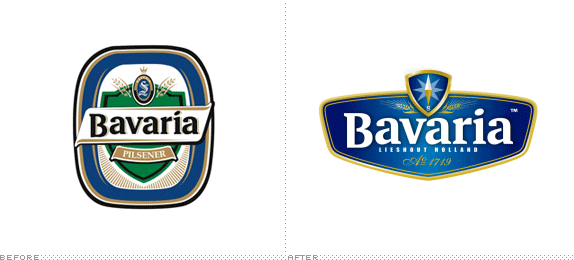
Brewing beer since 1719 — a good hundred years before its main competitor, Heineken — Bavaria is the second largest producer of beer in The Netherlands. I’m not a beer connoisseur by any stretch of the imagination but I drink enough of it and any kind of it, that I’m somewhat familiar with plenty of large brands but, for whatever reason, I had never heard of Bavaria. Or maybe I had and I may have even drank it, but the reality is that its existing look is so beer-generic and non-distinctive that I wouldn’t be able to pick it from a beer line-up if a party depended on it. Last month, Bavaria introduced a bold, cohesive new look for its range of beers that spans everything from the glass you drink it in to the crates you use to haul it home.
Continue reading this entry

DATE: Nov.19.2009 POSTED BY: Armin
POSTED BY: Armin CATEGORY: Consumer products
CATEGORY: Consumer products  COMMENTS:
COMMENTS:

TAGS:

Opinion BY Armin
Tonka gets Tougher, Sort of

Childhood. Trucks. Tonka. No questions asked. Well, at least not for us reading today who probably grew up with, or grew up wanting, one of those heavy, badass steel Mighty Tonkas that felt indestructible in our tiny hands — a far cry from today’s wussier Mighty Dump. Or anything else that Tonka makes these days, for that matter. Cute, chubby and safe, I’ll admit, but certainly not the vintage brand association that one makes with Tonka, the company that began making trucks in cold-as-hell Mound, Minnesota in 1947 manufactured by Mound Metalcraft Company. Part of Hasbro since 1991, Tonka’s line of toys are friendlier and have more plastic than steel, and somewhat recently they introduced a new logo that is slowly appearing in new packaging.
Continue reading this entry

DATE: Nov.12.2009 POSTED BY: Armin
POSTED BY: Armin CATEGORY: Consumer products
CATEGORY: Consumer products  COMMENTS:
COMMENTS:

TAGS:

Opinion BY debbie millman
Ninety Years of Refrigerators, and Logos
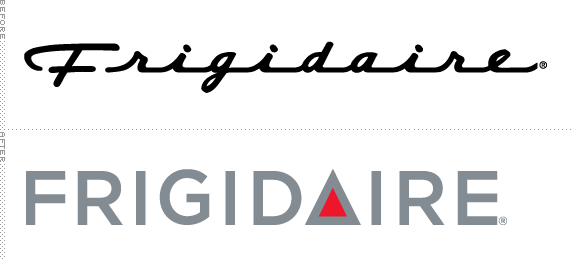
The Frigidaire brand celebrated its 90th anniversary in 2006. Still a leader today in the “white goods” (major household appliances), the company currently offers a line of appliances which include refrigerators, freezers, dishwashers, washing machines, dryers, microwaves, air conditioners, and both gas and electric stoves.
Continue reading this entry

DATE: Oct.19.2009 POSTED BY: (Display Name not set)
POSTED BY: (Display Name not set) CATEGORY: Consumer products
CATEGORY: Consumer products  COMMENTS:
COMMENTS:

TAGS:

Opinion BY Armin
Branding Milk, Chocolate, Candy and Pharmaceuticals
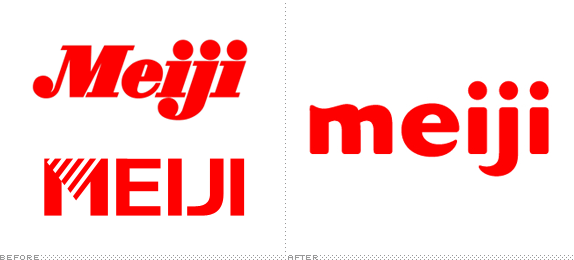
Established in 1916 and 1917 respectively — and shown top and bottom in the image above — Meiji Seika Kaisha and Meiji Dairies Corporation, have become one of the most well known brands in Japan. As the name of the latter implies, its specialty was processed milk products while the former focused on the (somewhat baffling) categories of confectionary and pharmaceuticals. This past April, the two organizations came together to form a single operation, Meiji Holdings Co., Ltd and along with it came a new logo, designed by the Tokyo office of Landor.
Continue reading this entry

DATE: Oct.14.2009 POSTED BY: Armin
POSTED BY: Armin CATEGORY: Consumer products
CATEGORY: Consumer products  COMMENTS:
COMMENTS:

TAGS:

Opinion BY Armin
Organic Cows Make Happy Yogurt
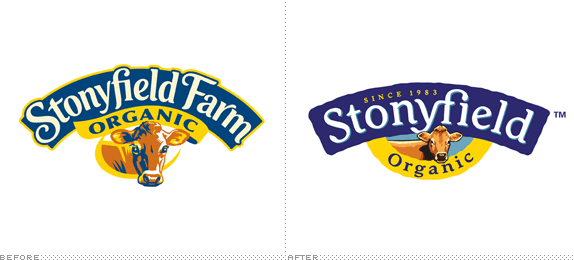
When it comes to yogurt I have no brand allegiance. Whatever brand happens to cross my line of vision that does not look like it will taste like creamy acid, I will grab. Granted, I don’t eat much yogurt, so I have no problem in brand continuity. Same thing with milk, whatever the house brand is at the grocery store near my home at the moment is the one I buy. For a while, in the halcyon economic times of 2007, we bought organic milk. Prior to writing this post, if you had asked me what brand of organic milk I bought I would not have been able to tell you. It was only as I was going through Stonyfield Farm’s web site that I realized the $5 gallon of milk I had been buying was Stonyfield Farms. This is not a knock on this particular brand but perhaps just my perception of the dairy category: A blurry landscape of cows, prairies and fruit drawings. Most likely, I’m not the target audience. Having said all this, Stonyfield Farm stands out from the crowd as a cow- and earth-conscious company since its modest beginning in 1979 as The Rural Education Center until 1983 when they began (pun alert!) milking their expertise and killer yogurt recipe as a consumer product. Today it is one of the most successful organic dairy product lines in the market, and it recently launched a new identity and packaging designed by Webb Scarlett deVlam
Continue reading this entry

DATE: Sep.17.2009 POSTED BY: Armin
POSTED BY: Armin CATEGORY: Consumer products
CATEGORY: Consumer products  COMMENTS:
COMMENTS:

TAGS:

Opinion BY Armin
Does This Type Make Me Look Slimmer?

Since my youthful video game exploits are oddly well documented here on Brand New, I’ll add to the well with another bit of useless personal information. It being that the last console I owned was an original PlayStation, which I wore out with several seasons of NBA Live. Since then, of course, two far more advanced generations of PlayStation have come into existence, with PlayStation 3 being the most recent. This September, without delving into Generation Four territory, PlayStation officially unveiled the latest update featuring a slimmer hardware design along with other software improvements and a streamlined new logo.
Continue reading this entry

DATE: Sep.16.2009 POSTED BY: Armin
POSTED BY: Armin CATEGORY: Consumer products
CATEGORY: Consumer products  COMMENTS:
COMMENTS:

TAGS:

Opinion BY Armin
My Little Logo
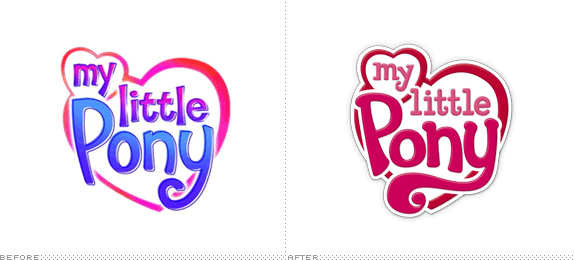
Although I am, or well, was, more of a He-Man, G.I. Joe, and Transformers kind of kid, I’m certainly not above acknowledging the ubiquity of My Little Pony as a popular toy for girls (at the time, obviously, with cooties). I’m probably not alone in having tortured a My Little Pony with any of the aforementioned manly action figures. But unlike these other 1980s boyish relics — 3d wizardry-driven movies of the latter two notwithstanding — My Little Pony has kept evolving over more than 25 years, adapting not only its design and packaging for contemporary kids but also by redrawing the features of the ponies, keeping them relevant to today’s aesthetics. If you played with them as a kid you may not like how they have evolved, with their super eyelashes and red carpet-ready manes, but check with the demographic and I am sure you will find them combing those manes.
Continue reading this entry

DATE: Sep.14.2009 POSTED BY: Armin
POSTED BY: Armin CATEGORY: Consumer products
CATEGORY: Consumer products  COMMENTS:
COMMENTS:

TAGS:

Opinion BY Sam Becker
Heartless Ice Cream

Summer may be winding down but the Good Humor truck is here to stay. The popular ice cream maker you might remember from such frozen hits as Strawberry Shortcake, Toasted Almond and Chocolate Eclair launched a rebrand earlier this year. It will adorn snack cart umbrellas, swimming pool menus and packages in the freezer aisle. But where’s the heart?
Continue reading this entry

DATE: Aug.27.2009 POSTED BY: Sam Becker
POSTED BY: Sam Becker CATEGORY: Consumer products
CATEGORY: Consumer products  COMMENTS:
COMMENTS:

TAGS:

Opinion BY Armin
Flubber-based Logo

Offering televisions (conventional, flat and LCD), washing machines, air-conditioners, refrigerators, audio products, home theatre systems and microwave ovens, produced through eighteen manufacturing facilities globally, India-based Videocon is one of the largest consumer products in its country and has its aim on global expansion. This past July Videcon unveiled its new identity in San Francisco with the help of Bollywood star Shah Rukh Khan.
Continue reading this entry

DATE: Aug.20.2009 POSTED BY: Armin
POSTED BY: Armin CATEGORY: Consumer products
CATEGORY: Consumer products  COMMENTS:
COMMENTS:

TAGS:

Opinion BY Armin
Very Bubbly
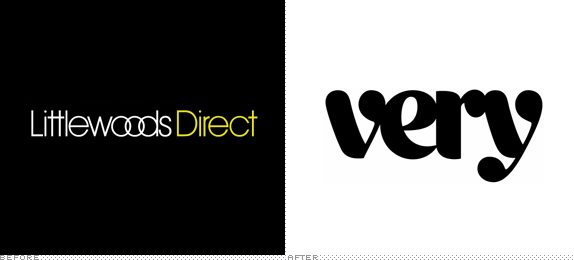
Originally established in 1923 as a soccer gambling business, Littlewoods expanded into a catalog retailer 1932 and even opened brick and mortar store in 1937 and its merchandise grew to include everything from clothing to electronics. In 2005, Littlewoods merged with Shop Direct and established Littlewoods Direct as the online and catalog consumer brand that in the last four years has become one of the leading retailers in the UK. And this past July, Littlewoods Direct rebranded itself as Very and repositioned to appeal to a younger demographic — 25 – 45 according to this article — with the help of Wolff Olins.
Continue reading this entry

DATE: Aug.18.2009 POSTED BY: Armin
POSTED BY: Armin CATEGORY: Consumer products
CATEGORY: Consumer products  COMMENTS:
COMMENTS:

TAGS:





























